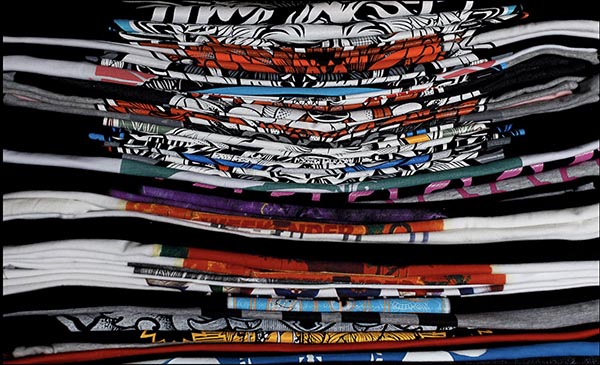DTG Printing Machinery SS/2023 Review: Stellar Growth and New Technologies to Explore
The use of digital textile printing machines for direct-to-garment (DTG), continues to grow rapidly and is gaining popularity worldwide. As a technology built to deliver speed to market, it’s built for on-demand production and as such sustainable manufacturing—driving down inventory and production costs. This article is written by Debbie McKeegan, a textile expert and WhatTheyThink contributor. It focuses on DTG opportunities as well as the expanding field of direct to-film garment printing.

(Image courtesy Texintel
With a predicted vertical rise in direct-to–garment (DTG), DTG production continues to grow. The DTG digital textile printing machine continues to be a highly successful business model that is gaining momentum worldwide. As a technology built to deliver speed to market, it’s built for on-demand production and as such sustainable manufacturing—driving down inventory and production costs.
DTG printing’s market value, which was US$822,000,000 in 2022, will rise to US$1,820,000,000 by 2032 at an annual growth rate 8.3% (FMI). This is more that doubling the size of the global market within a 10-year span. Experts attribute this to direct-to-garment print’s unique advantages. These advantages include ease of entry, a “nil finished inventory” business model, and moving in lockstep with the market shift to customization and print-on-demand ecommerce.
Innovations are a key driver for the sector.
Kornit Digital (KD) has made considerable strides with its inks particularly for polyester fabrics, where its Neopigment™ Olympia ink is its unique, innovative ink for high-quality printing on polyester, delivering a wider color gamut, solid color coverage, and precise Pantone color-matching. This eco-friendly, sustainable ink is made in-house and designed specifically for Kornit Systems to meet the highest sustainability standards.
You will enjoy outstanding durability and hand feeling, as well as a higher L value and greater opacity for bright print. Additionally, you can get increased strength and flexibility to increase print elongation. These attributes ensure that KD machinery meets the highest standards of retail quality and durability.
DTF (direct to film) technology is poised for even greater success. This area of print is fast and thick for quick garment production. DTF printing is one the most versatile methods in the print industry. It offers incredible color vibrancy, as well as fabric versatility. DTF printing can be used with more challenging fabrics like nylon, fleece, nylon and even classic cotton.
DTF printing is the process of printing a design onto PET film (a special film that allows for designs to be transferred). It uses water-based inks as well as a special powder adhesive. The PET film design is then heat transferred to fabric by a heat press. This printing method is durable and the design’s print quality is impressive, detailed, and the colors vibrant.
Roland DG and Mutoh are the leaders in this field with their BN-20d, Mutoh and Sublistar, respectively, with their VJ 628d and DTF 6002 Pro max DTF lines. Ricoh offers DTF printer options.
There are many apparel manufacturers that produce blanks for DTG. A wide variety of blank apparel is available to potential producers, including T-shirts, hoodies, sweatshirts, and V-necks. They can find it all at Bella Canvas in America and Fruit of the Loom in Europe. The demand for responsibly-sourced apparel is growing and the DTG industry is adapting to ensure that organic, certified and recycled polyester print bases and rPET recycled polyamide print bases are available.
The Brother GTX Pro bulk is your best option for sheer production and low prices. It can produce 14,000 T-shirts per week in a single 8-hour shift. Brother DTG Direct to Garment Printer Inks are manufactured according to Brother DTG’s exclusive formulation, providing the best possible results from a DTG printer.
These Brother Direct to Garment Printer Inks are among the first to not only carry the Oeko-Tex® Certification, but also to be GOTS APPROVED and CPSIA-compliant to help ensure they are safe for printing and are environmentally responsible. They also have the highest washfastness in DTG.
We look forward to the next year and return to the Kornit Digital DTG machine range. It offers the best in speed, efficiency and flexibility.
As if the XDI profile ink system isn’t enough, Kornit machines from the Atlas to the Vulcan provide the perfect platform for an up-to-date and profitable digital printroom and, in 2023, Kornit is about to promote its new Apollo system. The manufacturer recently unveiled the Apollo machine, which uses its Max technology to offer “the highest retail quality combined with full automation control and integrated smart curing processes.”
The printer also utilizes technology from Lichtenau, Germany-based Tesoma, Kornit’s most recent acquisition. Kornit said, “the single-step end-to-end system addresses accelerated post-pandemic market trends for streamlined supply chains and production nearshoring.”
After early customer engagements in 2022, it is expected that the product will be available by mid-2023.
The direct-to-garment sector is booming because of innovation, efficiency and rapid production.
We are also witnessing the emergence of hybrid machinery. The development of hybrid DTG printing where digital printing and screen printing can be combined is worth special attention. The Kyo Hybrid Digital Textile Printer (Aeoon, Austria) is a standout. The Kyo Hybrid Series, which combines screen and digital textile print, is the first to do so. It is the perfect printer for companies that need high volumes of production and has unique production flexibility.
You can combine both screen printing and DTG printing. This combination delivers a great finish and significant savings on the ink consumption.
DTG success stories range from Inkthreadable, Printful and more. The DTG sector is meeting the market expectations for a textile segment that will experience significant and irreversible expansion. There are many things to look forward to in the coming years, with DTF technologies and hybrid printing solutions.
www.texintel.com